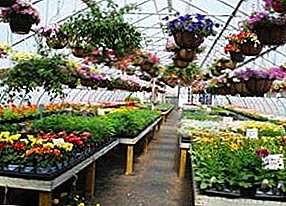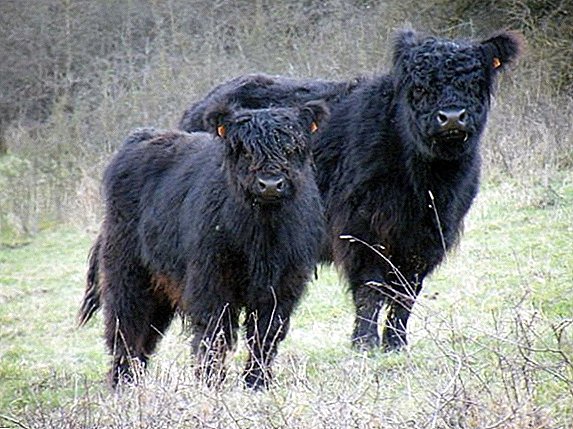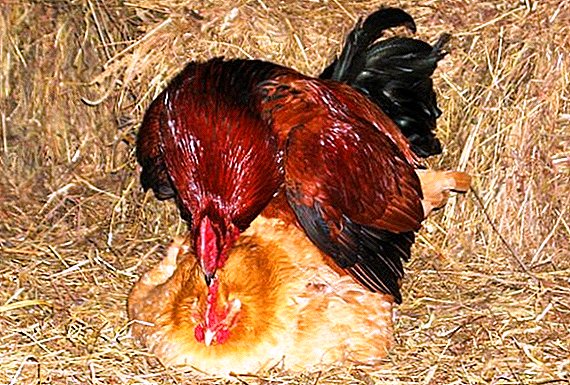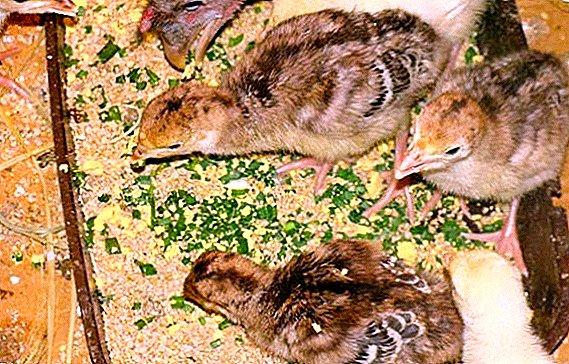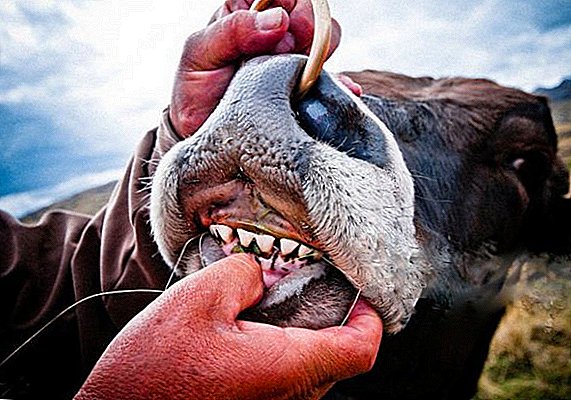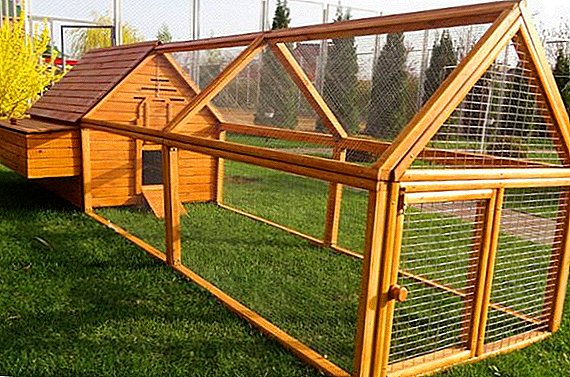 Chickens are not only a dietary meat product, but also a source of eggs, which are used in the production of a large number of food products. For good performance, these birds are not enough to have only regular and good food, they need a comfortable, well-built chicken coop that will hide from cold and rain, where they will sleep and carry eggs well. If you are going to start chickens in your yard, to save the budget you can build a comfortable bird house with your own hands, you just need to know all the details of the building.
Chickens are not only a dietary meat product, but also a source of eggs, which are used in the production of a large number of food products. For good performance, these birds are not enough to have only regular and good food, they need a comfortable, well-built chicken coop that will hide from cold and rain, where they will sleep and carry eggs well. If you are going to start chickens in your yard, to save the budget you can build a comfortable bird house with your own hands, you just need to know all the details of the building.
Aims and objectives of the internal arrangement of the chicken coop
In order for the chickens to grow quickly, not to hurt and regularly rush, they need to build a comfortable chicken coop or retool an existing barn. 
It should take into account:
- the number of birds that will live indoors, their age;
- how the coop will be used, all year round or only in summer. In winter, it is necessary to think about heating the room;
- the possibility of frequent cleaning and disinfection of the premises;
- how the space will be ventilated;
- the possibility of insulation, lighting, maintaining the necessary humidity;
- the use of environmental materials for the arrangement.
Learn how to choose a chicken coop when buying, how to build and equip a chicken coop with your own hands, how to build and insulate a winter chicken coop correctly, how to build a beautiful chicken coop.
When planning the space you need to take into account the area for keeping chickens:
- for meat breeds - 1 m area for 3 hens;
- for egg - 1 m area for 4 layers;
- for chickens - an additional 1 square of area for 14 chicks.
In order to take into account all the nuances of the internal structure of the chicken coop, you need to draw a plan of the structure and adjust the size of the building to the required area. Then place additional rooms, indicate a place for nests, perches, where the "dining room" and a place for walks will be located. 
How to equip the chicken coop inside and out
Bird dwelling equipment is intended to provide comfortable, round-the-clock living indoors. Not only the health of chickens, but also their growth and egg production rates depend on the temperature inside, the lighting of the coop, the availability of fresh air and humidity.
Did you know? Chickens mate with several roosters. At the same time, they are able to spew back the sperm of the weakest partner, leaving the one that will give healthy and strong chickens.
Floor and bedding
The chicken coop can be equipped with earthen, clay, wooden or concrete floors. It depends on the willingness and financial capabilities of the owner of the building. To use the building year-round, the ideal option would be a wooden floor.
It should be two layers with laying between the layers of insulation. Wood should be treated with antiseptic and fire-fighting composition, as well as for walls. A layer of lime is scattered on the floor, and then a bed of sawdust or straw is laid with a layer not thinner than 10 cm. 
In winter, the litter layer needs to be increased and peat added, which will favor chemical processes in the litter with heat generation. Clay or dirt floor is possible when placing the building on a hill, and so much dirt and dampness from it, which is unfavorable for chickens.
Walls
The most durable and robust construction is made of brick or cinder block, but in the winter for such a chicken coop requires additional heating. If the chicken coop is built from scratch, then the quick version is the skeleton one.
Erection rules:
- The thickness of the timber and insulation should be the same. Bars are installed at a distance of 60 cm from each other. Interconnected by runs.
- On the inside, a vapor barrier film is attached to the frame, and then plywood or OSB slabs are packed.
- Between racks fit insulation - basalt wool 15 cm thick.
- The heat-insulating layer from plywood is laid.
- The waterproofing from a diffusion membrane is stuffed.
- Crate is fastened, sheathing is mounted on it.
- At a height of 1 m from the floor are openings for windows. The glazing area is equal to ¼ of the floor area. As the windows you can put the finished frame with pull out the inside. The openings must be closed with a grid to protect against predators in the summer, when the windows are open.
 All wooden components of the chicken coop before installation must be treated with antiseptic. As such, you can use Pinotex or Senezh. To protect against fire, it is necessary to carry out the treatment with the acid composition "Antal", which impregnates wood well and at the same time it "breathes".
All wooden components of the chicken coop before installation must be treated with antiseptic. As such, you can use Pinotex or Senezh. To protect against fire, it is necessary to carry out the treatment with the acid composition "Antal", which impregnates wood well and at the same time it "breathes".Important! Window openings better located on the south side.
Lighting
Daylight hours for birds range from 12 to 15 hours per day, so if the house is used only during the summer period, then only glazed windows in the room will suffice. When year-round breeding birds need to take care of additional lighting in winter.
You can use low-power lamps at the rate of 5 W per 1 sq. M. m square.
Find out what should be a light day in the coop and what should be the lighting in the coop in the winter.
Knowledgeable farmers equip lighting with infrared lamps, which have several advantages:
- They are not only a source of light, but also additionally heat the room (especially cages with chickens), are installed at least 0.5 m from heating objects, while the nests remain in the shade.
- Light bulbs promotes health and helps to digest food well.
- Promote dry litter, maintaining the necessary moisture.
- Act soothingly on the birds.
- Warm those places where their light falls.
- Easy to install and replace in case of breakage.

This type of lighting has several drawbacks:
- Considerable electricity consumption.
- When used improperly, fail quickly. At hit of water of a lamp burst. Therefore, you need to have away from the drinkers and apply protective covers of the nets for lamps.
Important! For good egg production, it is necessary to provide an 18-hour daylight a day. To automate the process, you need to set a timer that will automatically turn off the lighting. For the rest of the birds need darkness.
Electrical wiring in the poultry farm should be laid in metal hoses or pipes. Chickens are poorly oriented in the dark, so it’s better if the light goes out gradually, first the main lamps, then 15 minutes later.
Such a manipulation will allow the birds to perch on perches, and from the sudden complete blackout of the light, chickens fall asleep in the places where they are at the moment.
Ventilation
For a comfortable keeping of birds in the hen house, ventilation is necessary, which helps to remove unpleasant odors from the vital activity of chickens, to maintain the temperature and humidity in the room at the same level. The temperature regime of the room should fluctuate within the limits of + 10 ... +15 ° С. 
Ventilation can be of two types:
- Natural supply and exhaust. Air flow occurs through the gap between the door and the floor, and the exhaust through the installed in the upper part of the wall or in the ceiling pipe with a diameter of 20 cm and a height of 1 m above the roof. Installed in small spaces. Also, additional fresh air is supplied by opening the door, and the exhaust through open windows.
- Forced. In the exhaust duct is installed fan, for which you need to connect to the mains. This type of system is installed in large chicken coops.
Perches
The second important element in the chicken coop is the roost, since chickens spend most of its time on it. For their construction, rounded bars measuring 4 to 6 cm are needed. The length of the stick is equal to the distance between the walls of the chicken coop. The number of roosts depends on the livestock - 30 cm per hen is needed.
Bars are installed on the principle of steps (just not under each other) or all the poles on the same level. 
Above the level of the floor, the roost is placed at an average height of 50 cm. This size varies depending on the type of hen - fat birds, and this height may be inaccessible.
The perch is set at a distance of 25 cm from the wall, and 40 cm between adjacent bars.
Nest
Birds of a good egg variety carry eggs almost daily, therefore the nest is the main place for laying hens. Their number depends on the number of birds in the hen house. One nest is designed for 4-5 hens.
Birds for laying choose a secluded place, so arrange nesting in a quiet and dark place in the room.  For the nest, it is possible to build inclined structures with a compartment for collecting eggs, and it is also possible to use simple drawers or baskets for laying nests - the main thing is that the hens are comfortable.
For the nest, it is possible to build inclined structures with a compartment for collecting eggs, and it is also possible to use simple drawers or baskets for laying nests - the main thing is that the hens are comfortable.
The dimensions of the egg crate are: not less than 0.3 m in length and width, and 0.4 m in height. The drawers on top must be closed so that the chickens do not sit on the edges and do not soil the eggs with droppings. At the bottom of the nest you need to put straw or sawdust.
Drinkers and feeders
For normal life in an accessible place for chickens and owners, it is necessary to install feeders and drinkers. They are located at the level of the height of the back of the bird - chickens will pull the neck, but at the same time with their paws they will not scatter food on the floor.
Learn how to make drinkers and feeders for chickens, how to make an automatic and bunker feeder for chickens.
It is necessary to install so many devices so that all individuals can eat at the same time, so all birds will have the same development. The trading network offers various types of feeders and drinkers. Economy option - use the materials at hand at the site. 
The main thing is to know what materials you can use:
- Plastic and iron is well cleaned and disinfected.
- Wood is used only for dry food.
Swimming place
To clean the feathers from the louse and mites, chickens need to arrange sand baths. A large box filled with dry sand and wood ash is installed in the corner of the hen house, the components are mixed in equal proportions.
For every 10 kg of this mixture, you must add 200 g of sulfur, which allows you to form a thin protective layer under which the parasites die. The same bath can be installed in the summer in the pen.
Chicken Run
In order for the birds to freely walk in the open air, next to their dwelling you need to arrange a special area for walking, which must meet the following requirements:
- Not located on the site where the sun shines all day.
- The place must be dry, without growing grass harmful to the hens.
- The fence is better to perform from the grid-chain-link with small cells. The height of the walk is at least 2 meters, so that the birds could not fly, and the predators did not get into the territory. With the same purpose, the grid should be dug into the ground by 0.2 meters.
- The area of the pen is selected from the condition for 1 bird - 3 m of area. If it is possible to divide the walking in two parts, you can alternately sow grass, which is also an additional feed.
Important! If the territory for walking is closed from above, it will protect chickens from infections that wild birds spread.

Protection from predators
From uninvited guests in the form of rodents that harm chickens and spoil the eggs, you need to arrange protection:
- Under the foundation or walls you need to sketch sharp pieces of metal or broken glass.
- If the floor is not earthen, under it also need to jot down a sharp object.
- The building without foundation requires upholstery of the bottom of the walls with tin with a hollow into the ground by 0.3 meters.
- Ultrasonic repeller gives a good effect.
Did you know? Wood ash, added to the feed in the calculation of 2% of its weight, prevents the formation of ammonia in the body of chickens, which, in turn, reduces the amount of unpleasant odors in the chicken coop.
Coop Content
In order for the chicken population to add in weight and to carry high-quality eggs well, it is necessary to constantly carry out sanitary cleaning and disinfection of the premises. 
Cleaning a chicken coop consists of the following processes:
- Dry stage. It is necessary to remove litter, litter, feathers and food residues. Chickens are removed from the room, and then scrubbers clean the floor, walls and roost. If any elements in the room are made of metal, you need to process them with a gas burner.
- Wet stage All surfaces are washed using special detergents designed for the chicken coop. You can also use apple cider vinegar (2/3 of the amount of water) or soda ash (2%). If the walls have been whitewashed, this operation must be repeated with the addition of copper vitriol to the lime.
- Disinfection. It is carried out both organic and chemical substances. At home, you can use bleach, formalin, a mixture of manganese with hydrochloric acid - effective, but harmful and dangerous substances. It is better to use professional preparations that will simplify processing and completely destroy fungi and bacteria. In addition, these funds deposited on the surface, form a protective film, which for 1.5 months does not allow for the development of putrefactive processes.
The processing of bacteria and fungi should be combined with the cleaning and processing of the paddock and the area around the chicken coop. Asking how often you need to disinfect the house, you really need to look at the area of the room and the number of livestock in it. 
Full processing should be carried out once a year. Deep cleanings are done every six months. Ideally, disinfection should be done every two months, but before they are carried out dry cleaning and wet cleaning of the house is done.
All these works are carried out in overalls, gloves and rubber boots with the use of scrapers, scoop and broom.
You also need to daily check the area around the hen house for the presence of digging, which ferrets, weasels, foxes and rats can do.
If they are found, it is necessary to take measures:
- install electric scarer in the room;
- near trap place traps on both sides with bait;
- clean the area around the house from the boards and debris.
After reviewing the subtleties of the arrangement of the chicken coop, everyone can easily build such a structure in their own yard. And if you follow all the rules of arrangement and maintenance of the house, you can easily get a large yield of dietary meat and always have a sufficient number of eggs.



